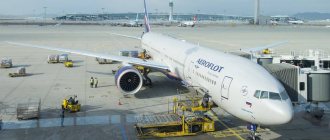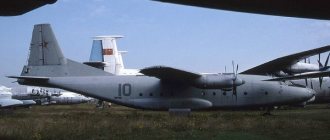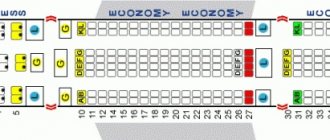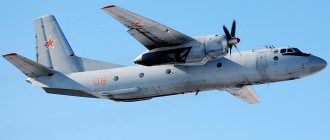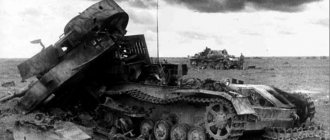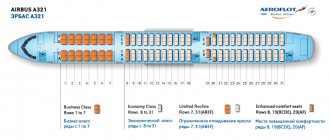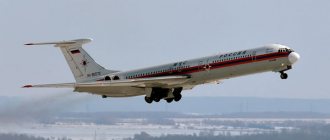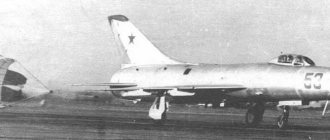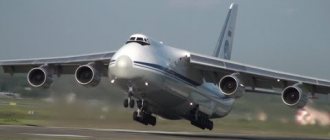Specifications
The Tu-134 aircraft (devil of the skies) is capable of covering distances of up to 2 thousand km without refueling, and gaining an altitude of 12 km. The passenger capacity of the car varies from 60 to 80 people (depending on the model). In aircraft operating on international routes, the cabin is divided into classes, and accordingly accommodates fewer passengers than domestic carriers.
Aircraft weight
Depending on the modification, the weight of the TU-134 changed. Thus, the mass of the empty basic design model with a glass nose was only 29,000 kg. At the same time, its take-off and landing weight corresponded to 43,000 kg, and the maximum take-off weight was 45 tons. But already the first production modification of the Tu-134A had a take-off weight of 47,000 kg, which allowed the machine to lift almost 20 tons of cargo into the air. For the modernized Tu-134B, the designers further reduced the weight of the empty aircraft, and thereby increased the vehicle's carrying capacity.
Airplane speed
The speed of the first Tu-134 models did not exceed 780 km/h , but soon the cruising speed parameters of modification A were increased to 850 km/h.
The modern Tu-134B-3 could reach speeds of up to 880 km/h, with the maximum capability of the vehicle being 1000 km/h.
For comparison, the cruising speed of the Boeing 737-500, produced in the late 80s, is 807 km/h.
Airplane drawing
Overhaul life
In 2002, Roscosmos and the Ministry of Transport of the Russian Federation approved the service life of Russian airliners. Thus, for the Tu-134 and its modifications A and B, which are operated by domestic enterprises, a time between overhauls was established in the amount of 8 thousand flight hours for 5 thousand flights for a period of 9 years (decision no. 24.9-113GA).
Aerodynamics of Tu-134A (Bekhtir)
In 1977, a manual for aviation universities was published by V.P. Bekhtir "Practical aerodynamics of the Tu-134A aircraft." The textbook describes in detail and clearly the geometric and layout calculations of the aircraft. The author analyzes the flight capabilities of the aircraft, both for standard situations and for emergency ones (in cases of engine failure or icing of the aircraft).
He emphasizes that it was the engineering decision to place the engines in the rear of the fuselage, on special pylons, that made it possible to improve the aerodynamic data of the airliner through the use of a “clean wing.” And also to minimize noise interference in the cockpit and in the passenger compartment, and to reduce the load exerted by gas jets of operating engines on the fuselage.
Airplane takeoff time
The take-off time of an airliner is affected by the weight of the aircraft and aerodynamic features:
- Wind;
- Atmosphere pressure;
- air humidity and other factors.
The average figure for the TU-134 is 56 seconds at a take-off speed of 170 km/h.
Design features of the Tupolev machine
The aircraft, which became the most popular passenger vehicle in Soviet civil aviation, had a design traditional for that time - a cantilever low-wing aircraft with engines located in the rear of the aircraft. The wing had a sweep of 350. The fuselage had a round configuration and, in comparison with its predecessor, the Tu 124 aircraft, was lengthened by 7 meters. The length and configuration of the fuselage made it possible to equip a fairly spacious cabin with 76 seats inside. On modification “A” aircraft, the length of the aircraft was increased by another half a meter by removing the navigator’s cabin. On a later modification of the aircraft with the "B" index, the number of seats was increased to 80 people. The ship's crew consisted of 4 people. In later modifications, it was decided to abandon the services of a navigator, and accordingly the crew was reduced to 3 people.
The tail unit received a “T-shaped” profile, giving the car a modern and swift look. The landing gear had three fulcrums, a nose landing gear and two wing struts, symmetrically located under the wings.
The propulsion system was represented by two D-30 turbojet engines. The first modification was equipped with Series I engines that did not have reverse gear. Later, starting with modification “A”, the aircraft began to receive improved Series II engines. Separate, specialized vehicles were equipped with D-30 Series III engines. The jet engines developed a total thrust of 13,600 kgf, lifting a 47-ton vehicle into the air.
The design of installing engines in the tail section significantly lightened the wing, thereby improving the aerodynamic characteristics of the vehicle. The noise from operating engines in the cabin has decreased, and the negative effect of the jet stream on the side skin of the aircraft has decreased. This scheme had its advantages, but was not without its disadvantages. The airframe of the aircraft became heavier, which reduced the efficiency of the engines.
The fuel supply on board the aircraft was 13.2 tons. Fuel was placed in wing fuel tanks and in the lower part of the fuselage, in soft fuel tanks.
Almost all machine control systems had hydraulic boosters. This primarily concerned the elevators, flaps and brake spoilers. The hydraulics had a main and an autonomous backup system.
The aircraft was equipped with fairly advanced flight and navigation equipment for its time. In addition to the on-board control system, the airliner was equipped with an automatic ABSU system, which provides control over the operation of all machine systems. The cockpit and interior had full radio equipment. On the latest modifications of aircraft, climate control systems began to be installed, equipped with anti-lightning tracking devices.
Hijacked in 1983
An attempt to hijack a Tu-134 occurred in 1983 in mid-November. Criminals hijacked a plane with the aim of escaping from the USSR. However, thanks to the professional actions of the crew, who resisted the terrorists, they managed to gain time and land the plane at the Tbilisi airport. Pilot Gabaraev, who was sitting at the controls, began to maneuver sharply to deprive the criminals of their balance. As a result, the load on the main supporting structures of the airliner was 3 times higher than the technically permissible one. During the maneuvers, the overloads reached critical levels of +3.15 and −0.6G. But the plane passed this test of strength with honor. The passengers and pilots were freed as a result of an assault carried out skillfully by special forces.
Content
- 1 History 1.1 Tests
- 1.2 Start of operation and further modernization
- 1.3 End of use
- 2.1 Glider
- 4.1 Tu-134 (1966—1970)
Passenger plane
The Tu-134 is a narrow-body passenger airliner, the commercial operation of which began in 1967. The very first flights showed how reliable, stable and easy to maintain this machine is. Thanks to the combination of such desirable qualities, the Tu-134 was purchased by German and Polish companies a year after entering mass production.
Cockpit
There are two main modifications of the Tu-134 - A and B. It is believed that model A has a glass nose, which provides the crew with enormous visual visibility, and type B aircraft have only a “wooden” nose, that is, a closed nose. In fact, the Tu-134A may also have an unglazed nose. The cockpit on such models is a bit cramped, and the navigator's seat is located almost in the aisle. This compromise decision was made by the designers in order to expand the luggage compartment, which is located directly behind the navigator. The famous “black box” is also located there.
The Tu-134B cabin is designed for a crew of 3 people, unlike the “A” model, which has 4 work seats.
The cabin of any modification of the Tu-134 also consists of several partitions, control panels, lightweight wall and ceiling decoration, plywood or foam luggage racks.
Takeoff of Tu 134. View from the navigation cabin.
Landing Tu 134. View from the navigator's cabin.
Salon
The two-class passenger cabin is the most widely used modification.
The business class cabin of the Tu-134 has softer seats. The distance between the seats is from 1 meter to 1.3, which allows them to be folded almost to a horizontal position without disturbing the comfort of the passenger sitting behind. Business class seats are located in the first 2 rows of the passenger cabin. The most attractive seats are those located near the windows, which provide excellent visibility to passengers. And the least convenient seats here are the 2nd row seats, bordering the aisle, as they are located in close proximity to the utility rooms and toilet.
In the economy class cabin, the seats are arranged, as in business, in the “2-2” type, and therefore there is a wide passage between them, which is not typical for the “economy” category. There are usually 14 rows in the cabin, but the count starts from 5. So the first row of economy is located at number 5, and the last row is at number 19.
The best economy class seats on the Tu-134 are located in rows 5 and 13, as they have more legroom than other seats.
And the worst seats were considered to be in rows 18-19 due to the proximity of the toilet facilities.
Tu-134 modifications
In the period from 1996 to 1984, 12 modifications of the Tu-134 aircraft were developed and produced, some of which had several versions.
- Tu-134 is a basic modification of the aircraft with a passenger capacity of up to 64 people (later - up to 72). It has a glazed nose, as well as a braking parachute to reduce the landing distance. Produced from 1966 to 1970.
- Tu-134A is a modification of the airliner, equipped with more advanced engines, which made it possible to abandon the use of braking parachutes to reduce the speed of the aircraft during landing. The operating efficiency of the aircraft has also been significantly improved. Thanks to the fuselage extended by 2 meters, the passenger capacity of the Tu-134 was also increased. The model was produced from 1970 to 1980.
- Tu-134B is an improved version of Tu-134A. It has less weight and a new layout of the passenger compartment. The aircraft crew was reduced (from 4 to 3 people). New emergency exits have been added. Some aircraft of this modification have additional fuel tanks, which allows them to increase their flight range. Serial production continued from 1980 to 1984.
- Tu-134LK is a modification that is a flying laboratory used mainly for space needs.
- Tu-134M is a modernized version of the Tu-134B, equipped with new engines.
- Tu-134S is a cargo modification of the aircraft.
- Tu-134СХ is a modification of the Tu-134 for agricultural use.
- Tu-134UBL (also called Tu-134A-4) is an aircraft used to train naval and strategic bomber pilots.
- Tu-134UBL-Sh is a specialized modification of the Tu-134UBL, designed to train navigators for naval and strategic aviation aircraft.
- Tu-134Sh (also referred to as Tu-134Uch) is an aircraft designed to train navigators for long-range and front-line bomber aviation.
- Tu-134Sh-SL is a modification used as a flying laboratory for testing radio-electronic equipment.
- Tu-134A-3M – VIP modification of the Tu-134. A total of 6 aircraft of this model were built.
Is it possible to buy?
Currently, purchasing a Tu-134 is not difficult. If the aircraft is in flight shape and still suitable for operation, its commercial value is from 1 million euros or more. Thus, an A-3 modification aircraft in good condition can be purchased for €1,005,870 or, respectively, $1,200,000, 70,260,000 rubles.
But often a car is purchased to equip a restaurant or entertainment center. Then its cost is noticeably reduced, because the buyer buys practically scrap. Decommissioned cars are great for this.
However, these aircraft will soon become a rarity. Now only 120 machines are in operation and 100 of them are in the Russian Federation. Prudently themed museums and historical parks are already taking care of acquiring the legendary “carcass” for their arsenal.
Over its half-century history, the Tu-134 has demonstrated reliability and efficiency, meeting the requirements of the time. And small companies operating domestic medium-haul flights continue to use it. Tu-134s are purchased by flight schools for training flights. The airliner has found application not only in civil aviation; some of its modifications are used in military aviation. The Tu-134 is also used for private passenger transportation. Domestic businessmen who value their time find the optimal balance of price, reliability and comfort in this aircraft.
Links
- Tupolev Design Bureau
- Kharkov State Aviation Production Association (KSAPP)
- Photos of Tu-134 on the website ScaleModels.ru
- L. L. Selyakov “THE THORNY PATH TO NOWHERE. WORK OF OKB A. N. TUPOLEV
- Tu-134 on the “Service and Technologies” website (inaccessible link from 09/28/2013 (613 days))
- Tu-134 - a flying legend
- Kravchun P.N. Tu-134: 40 years at Pulkovo // Part 1 - Wings of the Baltic. 2010. No. 5. P.66-74; Part 2 - Wings of the Baltic. 2011. No. 1. P.41-48.
| Aircraft of the Tupolev Design Bureau | |
| ANT series | ANT-1 • ANT-2 • ANT-3 “Proletarian” • ANT-4 “Country of Soviets” • ANT-5 • ANT-6 • ANT-7 • ANT-8 • ANT-9 • ANT-10 • ANT-13 • ANT-14 • ANT-16 • ANT-17 • ANT-20 “Maxim Gorky” • ANT-21 • ANT-22 • ANT-23 • ANT-25 • ANT-26 • ANT-27 • ANT-29 • ANT -31bis • ANT-35 • ANT-36 • ANT-37 • ANT-40 • ANT-41 • ANT-42 • ANT-44 • ANT-46 • ANT-51 |
| Military | DI-8 • DIP • I-1 • I-2 • I-3 • I-4 • I-5 • I-8 • I-12 • I-14 • Mi-3 • R-3 • R-6 • R-7 • SDB • TB-1 • TB-3 • TB-4 • TB-6 • TSh-B • FB • Tu-1 • Tu-2 • Tu-4 • Tu-6 • Tu-8 • Tu- 10 • Tu-12 • Tu-14 • Tu-16 • Tu-22 • Tu-22M • Tu-22MR • Tu-24 • Tu-28 • Tu-64 • Tu-70 • Tu-73 • Tu-75 • Tu-78 • Tu-80 • Tu-81 • Tu-82 • Tu-85 • Tu-88 • Tu-89 • Tu-91 • Tu-95 (Tu-96) • Tu-98 • Tu-107 • Tu -119 • Tu-121 • Tu-126 • Tu-128 • Tu-134UBL • Tu-142 • Tu-160 • Tu-214ON • Tu-214R • PAK DA |
| Passenger | Tu-70 • Tu-104 • Tu-110 • Tu-114 • Tu-116 • Tu-124 • Tu-134 • Tu -144 • Tu-154 (Tu-164) • Tu-155 (Tu-156) • Tu-204 (Tu-214 • Tu-204-300) • Tu-214SR • Tu-214PU • Tu-214SUS • Tu-334 |
| Amphibians | MDR-2 • MDR-4 • MK-1 • MR-6 • MRT-1 • MTB-1 • MTB-2 • MER • amphibious snowmobile A-3 |
| Unmanned | Tu-121 “S” • Tu-123 (“Yastreb-1”, DBR-1) • Tu-139 (“Yastreb-2”, DBR-2) • Tu-141 (“Strizh”, VR-2) • Tu-143 (“Flight”, VR-3) • Tu-243 (“Flight-D”, VR-3D) • Tu-300 “Korshun” |
| Projects | Tu-130 • Tu-135 • Tu-136 • Tu-206 • Tu-230 • Tu-244 • Tu-324 • Tu-330 • Tu-344 • Tu-404 • Tu-414 • Tu-444 • Tu- 2000 |
Tu-134, Tu-134 video, Tu-134 on BGA, Tu-134a, Tu-134a-4, Tu-134b, Tu-134ubl
Interesting Facts
There are many legends about the Tu-134, but, as always, the truth is often much more interesting. Several true historical facts related to this car, which have already become a legend:
- The first secretary of the USSR, Nikita Khrushchev, traveled to France. There he was shown the latest achievement of Parisian designers, the Caravelle aircraft. And they not only showed it, but also gave it a ride. Khrushchev liked it, and, returning to Moscow, he ordered the Tupolev Design Bureau a similar model, but even better. So, with the light hand of Nikita Sergeevich, the first flight of the Tu-134 took place in 1963.
- Once, during a test flight, a Tu-134 was struck by ball lightning, so powerful that its discharge almost capsized the plane. The lightning “floated” into the cockpit of the pilots and flew over the head of one of them, then flashed brightly, played with all the colors of the rainbow and went into the cabin, where it disappeared without a trace. The pilots escaped with serious fear, but the plane landed as normal. After examining the plane, it turned out that some parts had melted a little, and the skin of the plane was riddled with barely noticeable holes, as if someone had pierced it with an awl.
- Tu-134 is the first Soviet passenger aircraft to receive an official international certificate.
- The Tu-134 airliner is truly legendary: it was the one that regularly replenished the elite aviation squad of the Soviet government. It’s hard to imagine anything more prestigious than such recognition. All aircraft were made to individual orders. Their equipment was carefully thought out and agreed upon at the highest level. So, on L.I.’s personal plane. Brezhnev, an ultra-modern (for those times) Tatra communications complex was installed, which allowed during the flight to communicate with a subscriber located anywhere on the earth. But the Minister of Defense, Marshal Grechko, surpassed Leonid Ilyich in terms of technology. His personal plane was equipped with the Karpaty satellite communications complex, for which there were no dark spots in the world at all.
- The first seats in the passenger cabin of an airplane are set with their backs forward, so that the person occupying such a seat sat facing the rest of the passengers, as if on a train.
- Tu-134 aircraft, which have flown their due dates and have earned an honorable rest, are installed in a number of Russian cities as monuments of Russian aviation and engineering. The liners can be seen at the airports of Murom, Ulyanovsk, Chisinau, Voronezh, Minsk, Riga, Poltava, Mogilev and other cities.
The Tu-134, designed more than half a century ago, is still recognized today as one of the most reliable and budget-friendly aircraft, and its aerodynamic capabilities are much higher than a number of more modern aircraft. Therefore, the living legend Tu-134 is still in the service of domestic aviation and is in no hurry to give up its position.
Notes
- ↑ 123
Registry of Tu-134 on russianplanes.net - ↑ 12
World Air Forces 2008 https://wikidata.org/wikipedia/Track:Q17415948″> - ↑ 12
Tu-134 on AirWar.ru - Tu-134 - Tupolev (Russian). www.tupolev.ru. Retrieved June 19, 2018.
- Air monuments
- . coollib.com. Retrieved July 6, 2020.
- ↑ 12
Tu-134A on airwar.ru - D-30 on avid.ru
- aviatehnic.ru // Tu-134 / Main GS
- Tupolev Tu-134A-3M RA-65930 a/k Jet Air Group - board card
- Tu-134 takes off from Aeroflot
- Aeroflot is decommissioning Tu-134 aircraft
- Lenta.ru: Economics: Medvedev instructed the government to get rid of the Tu-134
- Tu-134B-3 on civilavia.info
- Tu-134Sh on the website AirWar.ru
- Aviation Safety Network > ASN Aviation Safety Database > ASN Aviation Safety Database results
